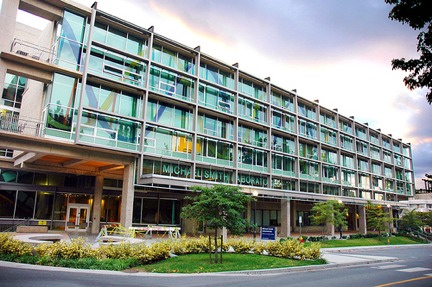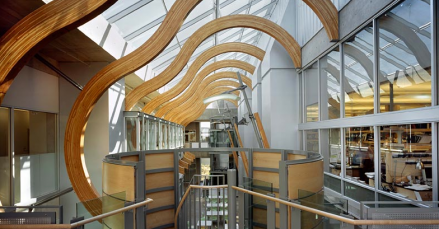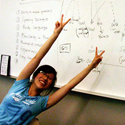Team:British Columbia/Notebook/Brainstorming
From 2011.igem.org
| Line 5: | Line 5: | ||
==May 2 2011== | ==May 2 2011== | ||
| - | |||
| - | |||
<p>The team came together and compiled a list of potential iGEM projects:</p> | <p>The team came together and compiled a list of potential iGEM projects:</p> | ||
| Line 19: | Line 17: | ||
*Biomolecules | *Biomolecules | ||
*Use DNA to control enzymatic reactions | *Use DNA to control enzymatic reactions | ||
| + | |||
| + | ==May 3 2011== | ||
| + | |||
| + | <p>The team came up with a few more ideas (ex. making bacteria clean water, cholera, inteins) and then shortlisted the ideas. Sam, Gurpal, and Joe will research photovoltaics. Marianne, Daisy, and Joe will research the cholera toxin; Vicki and Jacob will research bedbugs.</p> | ||
| + | |||
| + | ==May 4 2011== | ||
| + | |||
| + | We came together to discuss the shortlist of projects, and decided to focus on researching the potential pros and cons for cholera receptors and pine beetle pheromones. | ||
| + | |||
| + | ==May 5 2011== | ||
| + | |||
| + | Everyone was very passionate about the pine beetle project because of the relevant applications to the forests of British Columbia. Further, there is expertise close at home to collaborate with. Returning team members learned that it was difficult to obtain resources and hard to collaborate with scientists who were not in the same province (and country). | ||
| + | |||
| + | We established what we already know from the research we've done as well as gaps of knowledge. Some of our team members searched and contacted people relevant to our project to further discuss our project's feasibility. We also briefly discussed the objectives of our project. | ||
<html> | <html> | ||
<img src="http://blogs.ubc.ca/ubcinsiders/files/2010/04/Picture-11-439x229.png"> | <img src="http://blogs.ubc.ca/ubcinsiders/files/2010/04/Picture-11-439x229.png"> | ||
</html> | </html> | ||
| + | |||
| + | ==May 9 2011== | ||
| + | |||
| + | Dr. Joanne Fox begins a week of iGEM laboratory training in AMBL, the teaching lab in Michael Smith Laboratories. The training sessions run from 10am-4pm; Joanne provided short lectures so everyone understands the magic that goes on behind the actual bench work. Today, those present learned about restriction digests, and then set up restriction digests of the insert and vector in the morning. In the afternoon, we learned about purification kits, CIP assays, and ligation. | ||
| + | |||
| + | ==May 11 2011== | ||
| + | |||
| + | Marianne and Vicki (returning team members) went over labeling etiquette, lab book organization, and the 3-antibiotic method in the morning. | ||
| + | |||
| + | In the afternoon, the team returned to AMBL to conduct transformation experiments on Monday's ligated parts. | ||
| + | |||
| + | ==May 12 2011== | ||
| + | |||
| + | We did plate analysis, and started a culture for plasmid preps. Not everyone had colonies on their plates, so some had to steal others' colonies to start the culture. | ||
| + | |||
| + | In the afternoon, the team met up to discuss the pine beetle project in more detail - the objectives, the future applications/implications, the parts we need, the wet lab, modeling, and human practices components. | ||
| + | |||
| + | ==May 13 2011== | ||
| + | |||
| + | We mini-prepped the plasmids. | ||
| + | |||
| + | ==May 16 2011== | ||
| + | |||
| + | Mondays are when we have our weekly open lab meetings where interested faculty members/advisers as well as iGEM club members attend to hear about our project, provide any input/guidance. Today, we presented our project proposal to our advisers. The next step is to obtain all our necessary parts (Chris Keeling is generously giving us synthases) and to further develop our human practices and modeling routes. | ||
| + | |||
| + | [[File:canucksubc.jpg]] | ||
| + | |||
| + | ==May 18 2011== | ||
| + | |||
| + | Our first iGEM team social = bonding time! We all went to the Indian Oven to have dinner, discuss our project, and watch a part of the hockey game (Go Canucks!). It was semi-productive (in terms of project discussion). | ||
| + | |||
| + | ==May 23 2011== | ||
| + | |||
| + | We had our first modeling meeting at Blenz. Our modeling adviser, Shing, provided guidance on modeling the monoterpene production by yeast (model 1). Model 3 (google Earth) was briefly discussed and model 2 (protein homologue). Action items were established, and interested team members volunteered to work on a specific model: Gurpal and Sam will work on model 1 and 2, while Joe and Jacob work on model 3. | ||
| + | |||
| + | ==May 24 2011== | ||
| + | |||
| + | Because Monday (the 23rd) was Victoria Day, we had our usual open lab meeting today. Prior to the usual lab meeting, Daisy presented Chris Keeling's 2011 Transcriptome Mining paper. We then discussed the methods section, and outlined the reagents, protocols, and any equipment that we may need. Sam and Gurpal found papers from Greece and France that used other genes (mutant erg20-2, IDI1) that may aid in increasing the yield of monoterpenes by yeast; they will e-mail the respective principal investigators. | ||
| + | |||
| + | ==May 27 2011== | ||
| + | |||
| + | The team met up to discuss possible tracks, and came up with a "Synthase" track, and an "Extra parts" track. Marianne, Vicki, Daisy, Jacob, and Joe will be on the "Synthase" track, each taking on a different synthase; on the other hand, Laura, Gurpal, and Sam will be on the "Extra parts" track and will be in charge of liaising between us and the PI's in Greece and France in order to obtain the relevant plasmids/genes from them. | ||
| + | Vicki will write up the sponsorship package so everyone can begin contacting potential sponsors to obtain more funding. | ||
| + | |||
| + | ==May 30 2011== | ||
| + | |||
| + | We have finally secured a lab space (Thank you Ellis Lab!), and are in the process of moving equipment, unpacking, organizing, and ordering lacking supplies and/or reagents. | ||
| + | |||
| + | The sponsorship package is done, and we brainstormed potential companies/organizations to approach. | ||
| + | |||
| + | Gurpal has started working on model 1. He's found that Matlab would be the best program to use, and has gone through the SimBiology Kit Tutorials. He has also started writing out the biological pathways to produce monoterpenes. | ||
| + | |||
| + | Jacob and Joe have begun researching model 3 and started contacting relevant professors at UBC. | ||
Revision as of 15:31, 3 August 2011

 |
 |
 |
 |
 |

Contents |
May 2 2011
The team came together and compiled a list of potential iGEM projects:
- "Do It Yourself" biology (ex. build PCR machine)
- Optogenetics
- Chemo-signalling (using antibodies as signals)
- Rerouting networks (creating fusion proteins that make extra interactions to interfere with natural protein links)
- Eradicate bed bugs
- Eradicate pine beetles
- Battery waste
- Photo-dynamic inhibition (bacteria are killed by light)
- Biomolecules
- Use DNA to control enzymatic reactions
May 3 2011
The team came up with a few more ideas (ex. making bacteria clean water, cholera, inteins) and then shortlisted the ideas. Sam, Gurpal, and Joe will research photovoltaics. Marianne, Daisy, and Joe will research the cholera toxin; Vicki and Jacob will research bedbugs.
May 4 2011
We came together to discuss the shortlist of projects, and decided to focus on researching the potential pros and cons for cholera receptors and pine beetle pheromones.
May 5 2011
Everyone was very passionate about the pine beetle project because of the relevant applications to the forests of British Columbia. Further, there is expertise close at home to collaborate with. Returning team members learned that it was difficult to obtain resources and hard to collaborate with scientists who were not in the same province (and country).
We established what we already know from the research we've done as well as gaps of knowledge. Some of our team members searched and contacted people relevant to our project to further discuss our project's feasibility. We also briefly discussed the objectives of our project.

May 9 2011
Dr. Joanne Fox begins a week of iGEM laboratory training in AMBL, the teaching lab in Michael Smith Laboratories. The training sessions run from 10am-4pm; Joanne provided short lectures so everyone understands the magic that goes on behind the actual bench work. Today, those present learned about restriction digests, and then set up restriction digests of the insert and vector in the morning. In the afternoon, we learned about purification kits, CIP assays, and ligation.
May 11 2011
Marianne and Vicki (returning team members) went over labeling etiquette, lab book organization, and the 3-antibiotic method in the morning.
In the afternoon, the team returned to AMBL to conduct transformation experiments on Monday's ligated parts.
May 12 2011
We did plate analysis, and started a culture for plasmid preps. Not everyone had colonies on their plates, so some had to steal others' colonies to start the culture.
In the afternoon, the team met up to discuss the pine beetle project in more detail - the objectives, the future applications/implications, the parts we need, the wet lab, modeling, and human practices components.
May 13 2011
We mini-prepped the plasmids.
May 16 2011
Mondays are when we have our weekly open lab meetings where interested faculty members/advisers as well as iGEM club members attend to hear about our project, provide any input/guidance. Today, we presented our project proposal to our advisers. The next step is to obtain all our necessary parts (Chris Keeling is generously giving us synthases) and to further develop our human practices and modeling routes.
May 18 2011
Our first iGEM team social = bonding time! We all went to the Indian Oven to have dinner, discuss our project, and watch a part of the hockey game (Go Canucks!). It was semi-productive (in terms of project discussion).
May 23 2011
We had our first modeling meeting at Blenz. Our modeling adviser, Shing, provided guidance on modeling the monoterpene production by yeast (model 1). Model 3 (google Earth) was briefly discussed and model 2 (protein homologue). Action items were established, and interested team members volunteered to work on a specific model: Gurpal and Sam will work on model 1 and 2, while Joe and Jacob work on model 3.
May 24 2011
Because Monday (the 23rd) was Victoria Day, we had our usual open lab meeting today. Prior to the usual lab meeting, Daisy presented Chris Keeling's 2011 Transcriptome Mining paper. We then discussed the methods section, and outlined the reagents, protocols, and any equipment that we may need. Sam and Gurpal found papers from Greece and France that used other genes (mutant erg20-2, IDI1) that may aid in increasing the yield of monoterpenes by yeast; they will e-mail the respective principal investigators.
May 27 2011
The team met up to discuss possible tracks, and came up with a "Synthase" track, and an "Extra parts" track. Marianne, Vicki, Daisy, Jacob, and Joe will be on the "Synthase" track, each taking on a different synthase; on the other hand, Laura, Gurpal, and Sam will be on the "Extra parts" track and will be in charge of liaising between us and the PI's in Greece and France in order to obtain the relevant plasmids/genes from them. Vicki will write up the sponsorship package so everyone can begin contacting potential sponsors to obtain more funding.
May 30 2011
We have finally secured a lab space (Thank you Ellis Lab!), and are in the process of moving equipment, unpacking, organizing, and ordering lacking supplies and/or reagents.
The sponsorship package is done, and we brainstormed potential companies/organizations to approach.
Gurpal has started working on model 1. He's found that Matlab would be the best program to use, and has gone through the SimBiology Kit Tutorials. He has also started writing out the biological pathways to produce monoterpenes.
Jacob and Joe have begun researching model 3 and started contacting relevant professors at UBC.
 "
"















